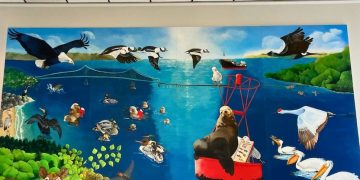Montana – Several of Montana’s cherished rivers are healthier today thanks to the work of Missoula conservationist Bruce Farling.
“Anything attributed to me is the result of working with really good volunteers and having great staff around me,” Farling said.
His induction to the Montana Outdoor Hall of Fame surprised, flattered and honored him, he said. “It’s a pretty distinguished crowd who some people think I deserve to be hanging with.”
As conservation director for the Clark Fork Coalition he helped organize the removal of Milltown Dam, which allowed migrating bull trout to once again swim up the Blackfoot River to spawn. Farther upstream, he pressed for cleanup efforts on the Clark Fork River where it had been degraded by decades of toxic runoff from historical tailings left in the Butte and Anaconda areas.
Farling fought the development of a gold mine on the upper Blackfoot River and worked with partners to remove nonnative lake trout in Flathead and Yellowstone lakes. On the Jefferson River, he fostered discussions between irrigators and agencies to restore a fishery long impaired by low water flows.
Such is part of the extensive environmental resume Farling created, an impressive record for a Pennsylvania boy who earned an environmental sciences degree from the University of Oregon.
“It’s hard to sum up someone who has been a key figure in every effort to care for Montana’s rivers and streams for the last 30 years or more,” said David Brooks, executive director and Farling’s successor at Montana Trout Unlimited.
“Bruce matches his passion for rambling in and getting to know wild places, with his tireless efforts to protect those things,” Brooks said. “His hard-charging, uncompromising advocacy and quick, cutting wit have meant that he’s failed to offend very few people in his orbit, friends and foes alike.”
Farling’s love of Montana was instilled as a youngster visiting family friends in Montana. After college he hired on with the Forest Service at the remote Moose Creek Ranger District in the Selway-Bitterroot Wilderness. Afterward he attended grad school for Journalism at the University of Montana, later landing a job as an intern at High Country News.
In 1994, Farling was hired by Trout Unlimited as its first full-time executive director. In the early 2000s, TU’s national office decreed that stream access initiatives were off-limits to state councils and chapters. The grumbling suggested deep-pocket donors were offended by a national crusade for public stream access.
Farling disagreed, and TU Montana led an uprising that forced the national office to back down. He also helped foster TU’s focus on native species in the state, including pallid sturgeon.
For the group’s 50th anniversary, Farling used his journalism skills to pen an early history of the organization in Montana.
Even after leaving Trout Unlimited, Farling continues to be a voice for conservation, publicly contesting the proposed building of an artificial play wave in the Clark Fork River in downtown Missoula. An enthusiastic whitewater paddler, he said he preferred nature’s waves to ones made by people.
The closing words of Farling’s historical account about the founding of Trout Unlimited in Montana could easily apply to him. “Few things we have accomplished, as well as hope to achieve, could have occurred without the early vision of a few forward-thinking anglers who knew this was a special place, with special rivers. We owe them much.”














